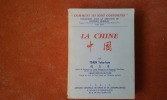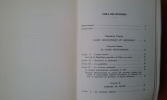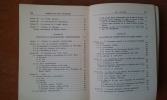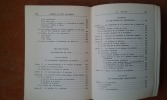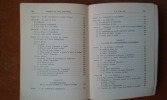TSIEN Tche-hao
La Chine
Librairie Générale de Droit et de Jurisprudence (LGDJ), 1976, in-8 br., III-742 p., coll. " comment ils sont gouvernés ", schémas et tableaux, bon état.
Reference : QWA-9219
Un des meilleurs livres de référence produit dans les années 1970, une étude très dense sur la vie politique de la Chine. Voir le sommaire sur photos jointes.
Bookseller's contact details
Librairie de la Garenne
M Christian Boyer
01 42 70 11 98
Payment mode
Sale conditions
Vente par correspondance uniquement. Conformes aux usages de la librairie ancienne et moderne. Les prix indiqués sont nets. Les frais de port sont en sus. Les livres peuvent être commandés ou réservés par téléphone, courrier ou courriel. Paiement par chèque ou virement
5 book(s) with the same title
Il faut comprendre la Chine
État : Très bon état - Année : 1935 - Format : in 12° - Pages : 270pp - Editeur : Librairie Académique Perrin - Lieu d'édition : Paris - Type : Reliure amateur demi-chagrin bordeaux, dos à quatre nerfs. - Divers : Complet de la carte en fin de volume. - Commander rapidement : https://www.bons-livres.fr/livre/william-martin/3192-il-faut-comprendre-la-chine?lrb
Préface d'Albert Thibaudet. Le récit d'un voyageur curieux et ouvert à la culture locale, doublé d'une critique politique, jamais complaisante mais sans caricature, de la société chinoise telle qu'un diplomate, journaliste et historien de surcroît, peut la percevoir dans la période troublée de l'Entre-deux-guerres. Une approche assez objective de la chine éternelle et des problème soulevés par l'influence du Japon en Extrême-Orient. Un livre important pour comprendre la Chine d'hier et d'aujourd'hui. Dans une reliure amateur de qualité en demi-chagrin bordeaux à coins et dos rond à quatre nerfs en excellent état.
Phone number : 09 63 58 85 14
La chine comme je la vois
État : Etat de neuf - Année : 1971 - Format : in 8° - Pages : 240pp - Editeur : Stock - Lieu d'édition : Paris - Type : Broché - Commander rapidement : https://www.bons-livres.fr/livre/pearl-buck/948-la-chine-comme-je-la-vois?lrb
Traduit de l'américain par Lola Tranec. L'ensemble des articles et conférences donnés par la grande romancière sur la Chine de son enfance et sur son évolution telle qu'elle pouvait la prévoir. Une approche qui n'est pas sans intérêt d'autant que toutes les prévisions de l'auteur se sont réalisées même celles qui se déroulent aujourd'hui. Donc un auteur à découvrir sur un sujet qui sera de plus en plus d'actualité.
Phone number : 09 63 58 85 14
Frère gaucher ou le voyage en Chine
L'age d'homme 1975 245 pages in8. 1975. broché. 245 pages.
Bon état
Chine - (grande carte incluse)
Hachette guides bleu 1989 992 pages in8. 1989. reliure editeur couverture rempliée. 992 pages.
Bon état
Paul et Virginie - La Chaumière indienne. L’un des 6 exemplaires sur Chine cités par Carteret de « la perle des livres illustrés du XIXe siècle » (Brivois).
Remarquable exemplaire relié avec faste par Mercier et parfaitement conservé. Paris, L. Curmer, 1838. Grand in-8 de 1 frontispice, lvi pp., 458 p., (7) ff., 1 carte coloriée à pleine page et 35 gravures à pleine page protégées par des serpentes. Maroquin bleu à grains longs, plats richement décorés d'un large encadrement formé d'une frise des même fers, avec plusieurs encadrements de filets dorés et à froid, et fleurons angulaires, dos lisse, titre et date dorés, décor en long formé de petits fers répétés, bordés de filets dorés multiples et d'un filet à froid, double filet doré aux coupes, contreplats bordés de maroquin orné de 9filets dorés, doublure et garde de satin moiré rose, tranches dorées sur témoins, chemise, étui. Mercier successeur de Cuzin. 240 x 157 mm.
« La perle des livres illustrés du XIXe siècle ». (Brivois). Remarquable exemplaire relié avec faste par Mercier et parfaitement conservé. Un des très rares exemplaires du tirage de tête sur papier de Chine. Il n'y en aurait eu que 15, ou 20, selon les deux prospectus consultés par Brivois. Magnifique édition considérée comme l'une des plus belles productions de l'époque romantique. Elle réunit Paul et Virginie et La Chaumière indienne, précédés d'une étude de Sainte-Beuve sur Bernardin de Saint-Pierre. L'illustration, due aux plus célèbres dessinateurs et graveurs du temps, comprend 29 planches sur Chine appliqué, dont le frontispice, et environ 450 vignettes dans le texte dessinées par Tony Johannot, Français, Meissonier, Paul Huet, Isabey, Marville, Steinheil et d'autres et gravées sur bois par Lavoignat, Brévière, Porret, O. Smith, Hart et d'autres, 7 portraits hors texte gravés sur acier par Cousin, Pelée, Pigeot et Revel d'après Lafitte, Johannot et Meissonier, et une carte coloriée de l'Île de France (actuelle Île Maurice) gravée par Dyonnet. Il a été joint un tirage volant de la page 417-418, comportant le portrait de madame Curmer (dit : « La bonne femme »), qui n'avait pas été imprimé dans les tout premiers exemplaires. Curmer ayant tiré Paul et Virginie à grand nombre, a employé une grande quantité de papier vélin, non collé, pour obtenir un tirage brillant de ses gravures sur bois. Dans l'ensemble de cette fabrication ou de ces fabrications il a été fait usage de feuilles de papier de force variable plus ou moins collées. C'est ainsi que les gravures sur acier et les grands bois hors texte sur chine ont été appliqués sur des papiers plus forts et sans colle qui se sont outrageusement piqués. Dans la livraison 29 se trouvait encarté un prospectus sur papier lilas annonçant 15 exemplaires sur chine à 500 francs, alors que la couverture de la 1ère livraison des portraits annonce l'ouvrage à 37fr.50, prix qui sera porté à 45 francs à la mise en vente, ainsi que 20 exemplaires sur chine à 300francs seulement l'exemplaire. Il existe des exemplaires sur chine avec le titre de la rue Saint Anne et d'autres avec l'adresse de la rue Richelieu. Le fait que Curmer a dépensé 3 335 francs en achat de papier de Chine, somme énorme pour l'époque, prouve, malgré l'emploi qui en a été fait pour le tirage des grands bois et des portraits, qu'il se rendait compte de la beauté des épreuves sur ce papier et qu'il comptait l'utiliser pour un tirage de luxe ; d'autre part, le nombre des exemplaires connus laisse supposer que le tirage du livre sur chine a sans doute été de 15 plus 20, soit 35 exemplaires au bas mot. L'éditeur qui vendait rarement un exemplaire sur chine le livrait avec le titre tantôt à sa première, tantôt à sa seconde adresse. Quelques exemplaires ont été complétés avec de grands bois hors texte portant Typ. Plon frères. « Presque tous les exemplaires reliés de leur temps sont très piqués, surtout les gravures hors texte, et ces taches d'humidité sont la cause que les amateurs, avec raison d'ailleurs, préfèrent constituer un bel exemplaire en reliure moderne avec toutes les herbes de la saint Jean ». L. Carteret. Précieux exemplaire sur Chine cité et décrit par Carteret. Sur les cinquante années qui vont de 1912 à 1962, Carteret cite 5 exemplaires sur Chine. Celui-ci atteint l’une des plus hautes enchères: de Montgermont ……………………………….... 4500 F V. …………………………………………..…… 9300 F Tristan Bernard, 1923 ………………………….….. 3600 F Renevey, 1924, le présent exemplaire.…………….. 8200 F Descamps. Scrive, 1925 ………………………..….. 17000 F Depuis 1967, Carteret cite un seul exemplaire sur Chine : Roudinesco, 1967 ; puis Esmérian (11 décembre 1973, n° 108) 41 270 FF soit 6 310 €. L’exemplaire sur Chine relié pour Ferdinand Philippe d’Orléans fut vendu 120 000 FF (18 350 €) le 5 juin 1987 (Réf : Livres Précieux, n° 219). Superbe exemplaire sur Chine de la bibliothèque Eugène Renevey (vente 1924, n° 141) avec ex-libris gravé sur Chine volant.
 Write to the booksellers
Write to the booksellers